Since one of the benefits of going to business school is to help young professionals advance in their career, many MBA applicants (and current MBA students) are interested in seeing the employment outcomes for recent graduates. In response, business schools survey their MBA graduates and issue employment reports which highlight successful MBA job placement outcomes by region, industry and function. It is important to keep in mind that a lot of the information prominently displayed in the MBA employment reports is gathered from the subset of recent MBA graduates who were seeking employment and accepted a job offer within three months of graduation.
Note: Recent MBA graduates who were not ‘seeking employment’ typically fall into one of three categories: 1) MBA graduates continuing with their graduate education (joint degrees, etc.), 2) MBA graduates returning to their previous employer (sponsored or otherwise), or 3) MBA graduates starting a business.
When reviewing the MBA career reports, one key takeaway for MBA applicants to consider is the wide variation across MBA programs in the percent total of MBA graduates who actually receive and accept a job offer within three months of graduation. Let’s review the data in this edition of Top MBA Program Career Placement Outcomes.
MBA Graduates Seeking Employment
Here is a table showing the Class of 2021 Graduates Seeking Employment as a percent total of Class of 2021 Graduates for 14 MBA Programs.
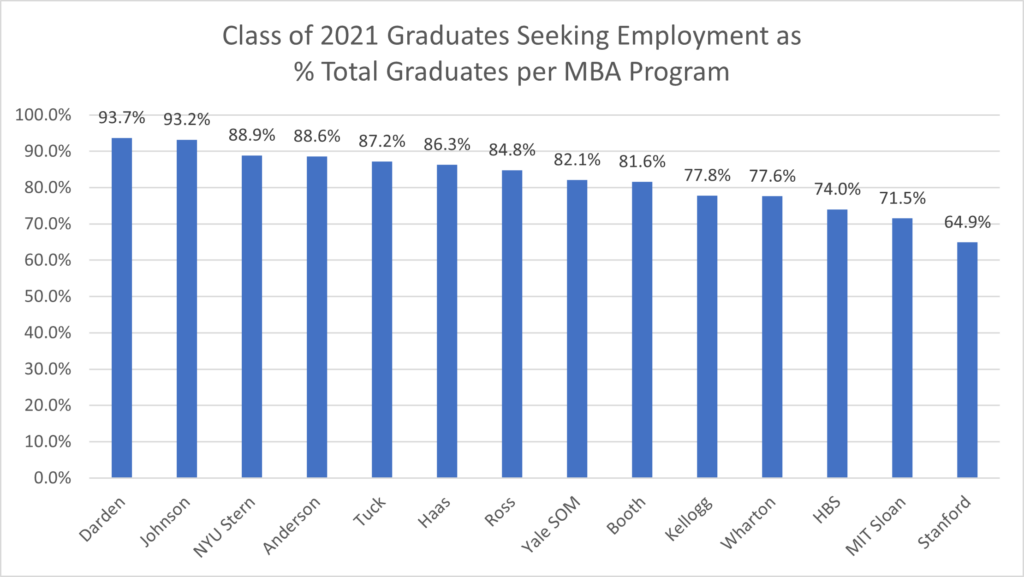
As you can see, there is a wide variation by MBA program in terms of the percentage of the graduates who are seeking employment. Stanford GSB has the lowest (64.9%) while Darden (93.7%) and Johnson (93.2%) have the highest.
MBA Graduates Seeking Employment Who Receive a Job Offer and Accept a Job
There is also variation regarding the MBA graduates who receive job offers and accept job offers as a percent of the total MBA graduates who are seeking employment. Here are two charts compiled from the employment reports of 16 MBA programs showing the percent total of Class of 2021 graduates seeking employment who received at least one offer and accepted one job offer. The first chart is sorted by percent of job offers received:
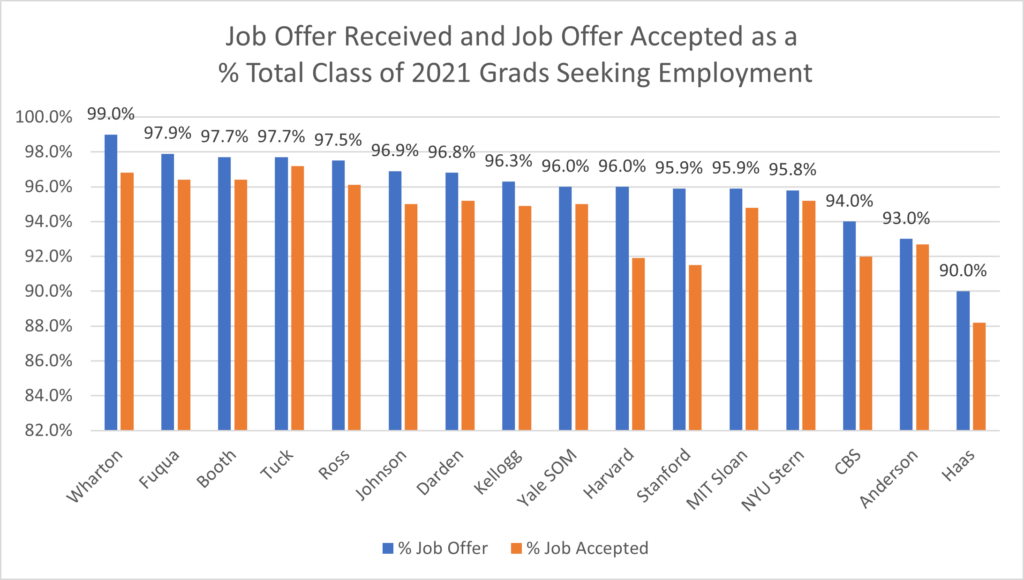
All of these MBA programs help over 90% of their MBA graduates seeking employment receive at least one job offer. In fact, 13 of the 16 MBA programs have a 95%+ success rate. In addition, it is interesting to see the variation in these metrics across business schools. For example, of the Class of 2021 graduates seeking employment, Wharton (99%) and Fuqua (97.9%) report the highest percentage of Class of 2021 graduates seeking employment who received job offers compared to only 93% for Anderson and 90% for Haas.
And here is the same chart sorted by percent of job offers accepted:
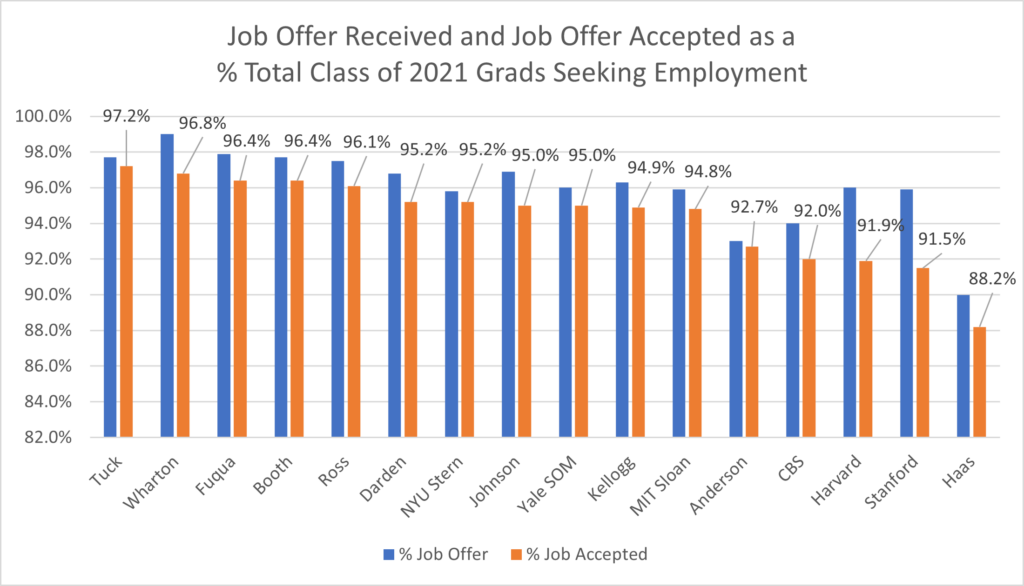
Of the MBA graduates seeking employment, Tuck boasts the highest percentage who accepted a job (97.2%). More broadly, there are five MBA programs (Ross, Booth, Fuqua, Wharton and Tuck) reporting that over 96% of their MBA graduates seeking employment have accepted a job and six more MBA programs (MIT Sloan, Kellogg, Yale, Johnson, NYU Stern and Darden) report a job acceptance rate of between 94.8% – 95.2%. It is a good quality signal for an MBA program to have a high percentage job acceptance rate among MBA graduates who are seeking jobs and it makes sense for business schools to highlight these acceptance rates in large font in the employment reports.
What is interesting is that UCLA, CBS, HBS, Stanford GSB and Haas have lower job acceptance percentages. For Anderson Class of 2021 graduates, their percent of jobs accepted is actually close to their percent of jobs offered. Meaning, most of the Anderson graduates who received a job offer accepted an offer. The constraint seems to be that 7.3% of Anderson graduates seeking employment were unable to land a job within three months of graduation. Haas is also a bit of an outlier with the lowest percentage of job offers (90%) and job acceptances (88%). It is also curious to see that three of the five programs that have the lowest jobs accepted percentages are located on the West Coast with deep ties to the West Coast tech community.
Another interesting observation is that both HBS and Stanford have a four percent spread between job offers received (about 96%) and job offers accepted (about 92%). This can be seen in the following chart:
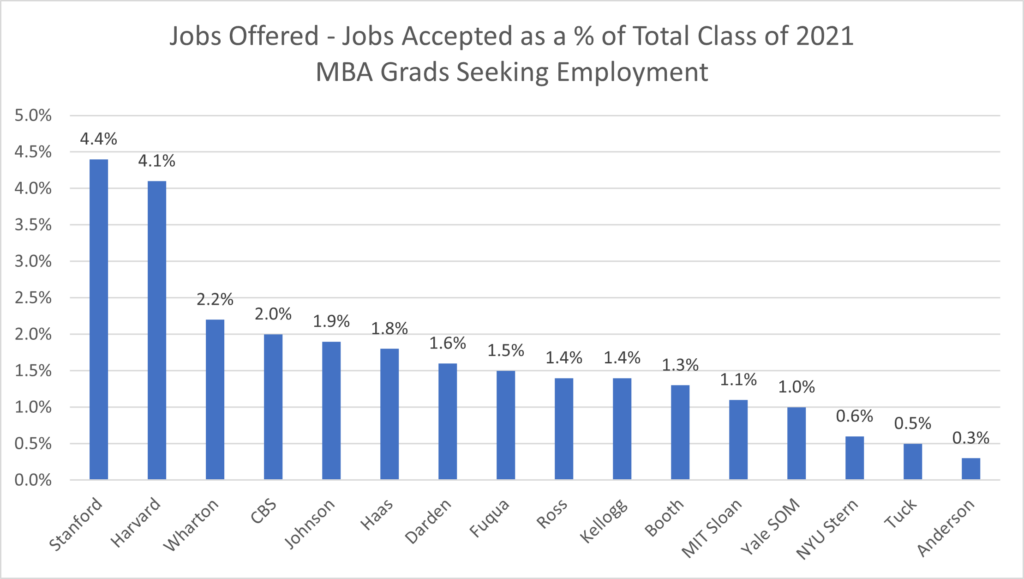
Given the large number of HBS and GSB students pursuing entrepreneurship, perhaps that gap is a reflection of HBS and GSB graduates electing to turn down a job offer and start a business instead.
Determining MBA Graduate Jobs Accepted as Percent of Total MBA Graduates
Since we know what percentage of total Class of 2021 graduates are seeking employment, and we know what percentage of graduates seeking employment have accepted a job offer, we can then multiply these together to determine what percentage of the graduating Class of 2021 has accepted a job offer:
| School | % Seeking Jobs of Total Class 2021 Grads | % Accepted Jobs of Total % Seeking Jobs | % Accepted Jobs of Total Class 2021 Grads |
| Darden | 93.7% | 95.2% | 89.2% |
| Johnson | 93.2% | 95.0% | 88.5% |
| Tuck | 87.2% | 97.2% | 84.8% |
| NYU Stern | 88.9% | 95.2% | 84.6% |
| UCLA | 88.6% | 92.7% | 82.1% |
| Ross | 84.8% | 96.1% | 81.5% |
| Booth | 81.6% | 96.4% | 78.7% |
| Yale SOM | 82.1% | 95.0% | 78.0% |
| Haas | 86.3% | 88.2% | 76.1% |
| Wharton | 77.6% | 96.8% | 75.1% |
| Kellogg | 77.8% | 94.9% | 73.8% |
| Harvard | 74.0% | 91.9% | 68.0% |
| MIT Sloan | 71.5% | 94.8% | 67.8% |
| Stanford | 64.9% | 91.5% | 59.4% |
Here is the same information viewed in a chart:
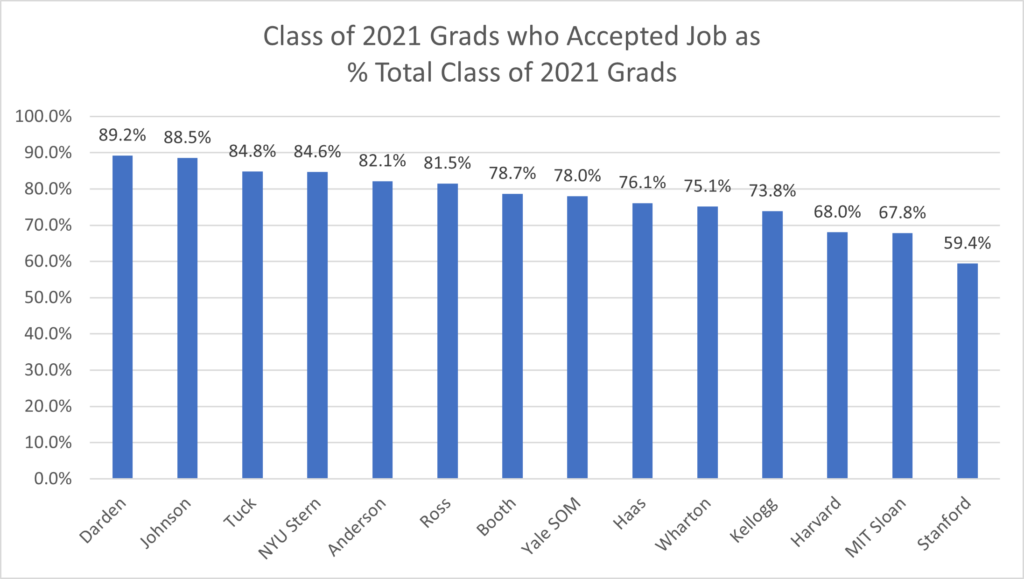
It is interesting to see that only 59% of Stanford GSB graduating Class of 2021 reported seeking employment and accepting a job. In contrast, over 88% of the Class of 2021 for both Johnson and Darden reported seeking employment and accepting a job.
Since MBA career offices use this ‘jobs accepted’ metric as the denominator in a lot of the published statistics, it is important to note that there is a wide variance in the percent total of the graduating Class of 2021 that is tracked in the employment reports. “The large variance across MBA programs in the percentage of MBA graduates seeking employment is a helpful metric for MBA applicants to track, especially for those MBA applicants interested in starting a business right after business school” said Graham Richmond, Clear Admit Co-Founder. “In addition, it is important to note that some business schools have Class of 2021 graduates not seeking employment because these graduates are company sponsored, and other business schools – like Stanford GSB – have 18% of Class of 2021 graduates not seeking employment because these graduates are starting their own business.”






